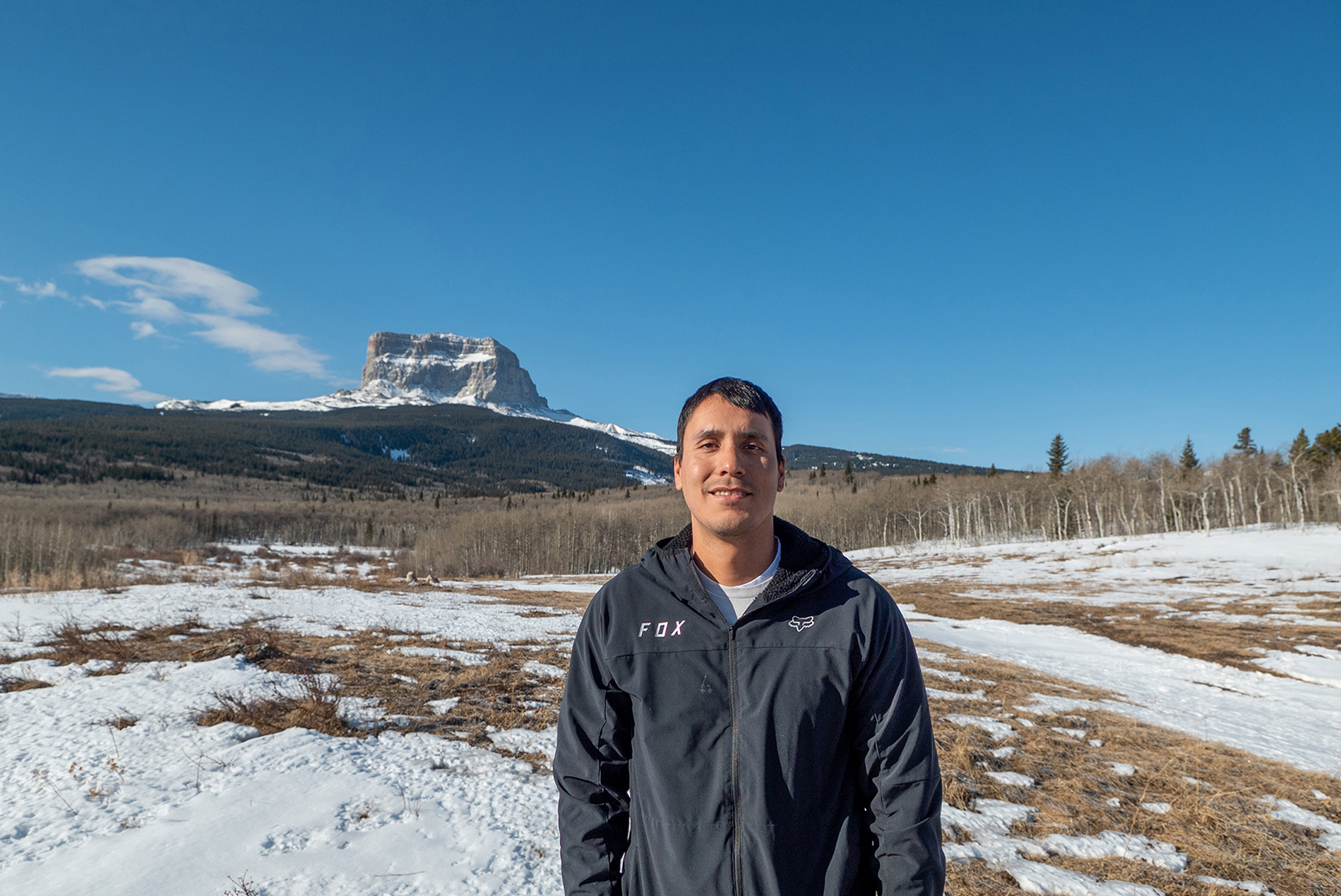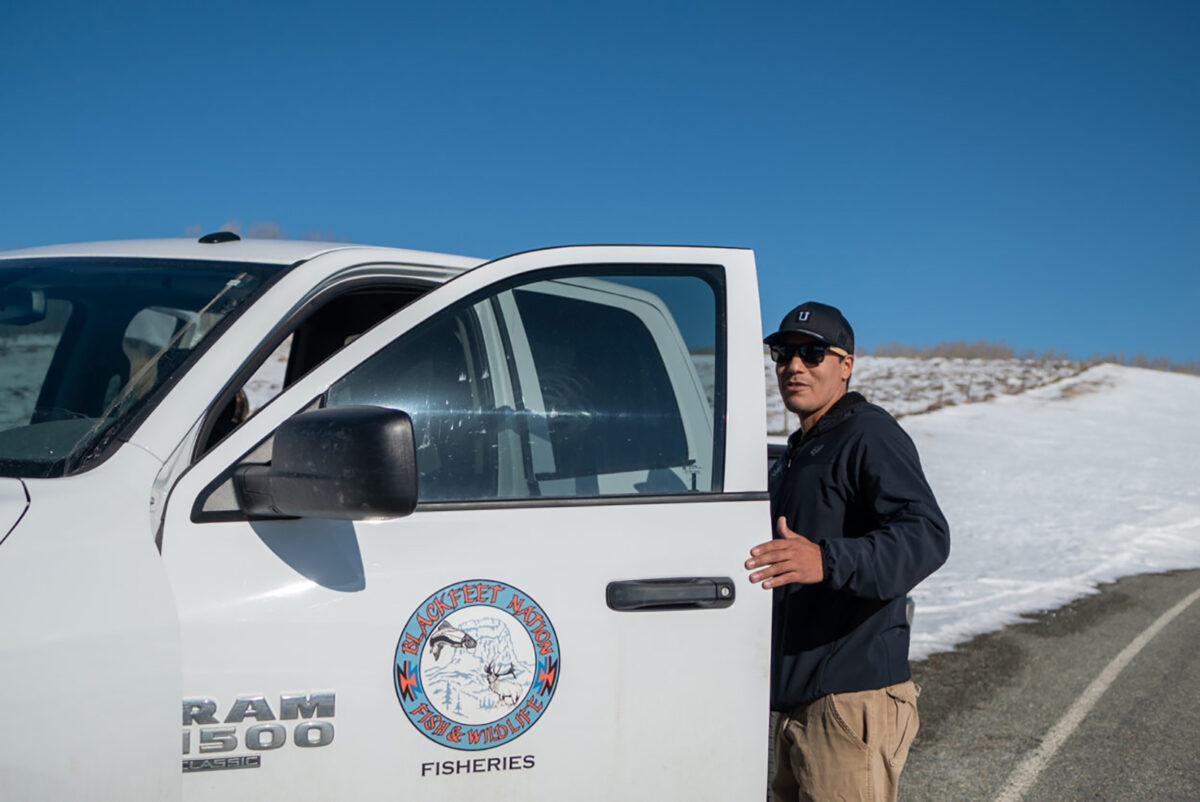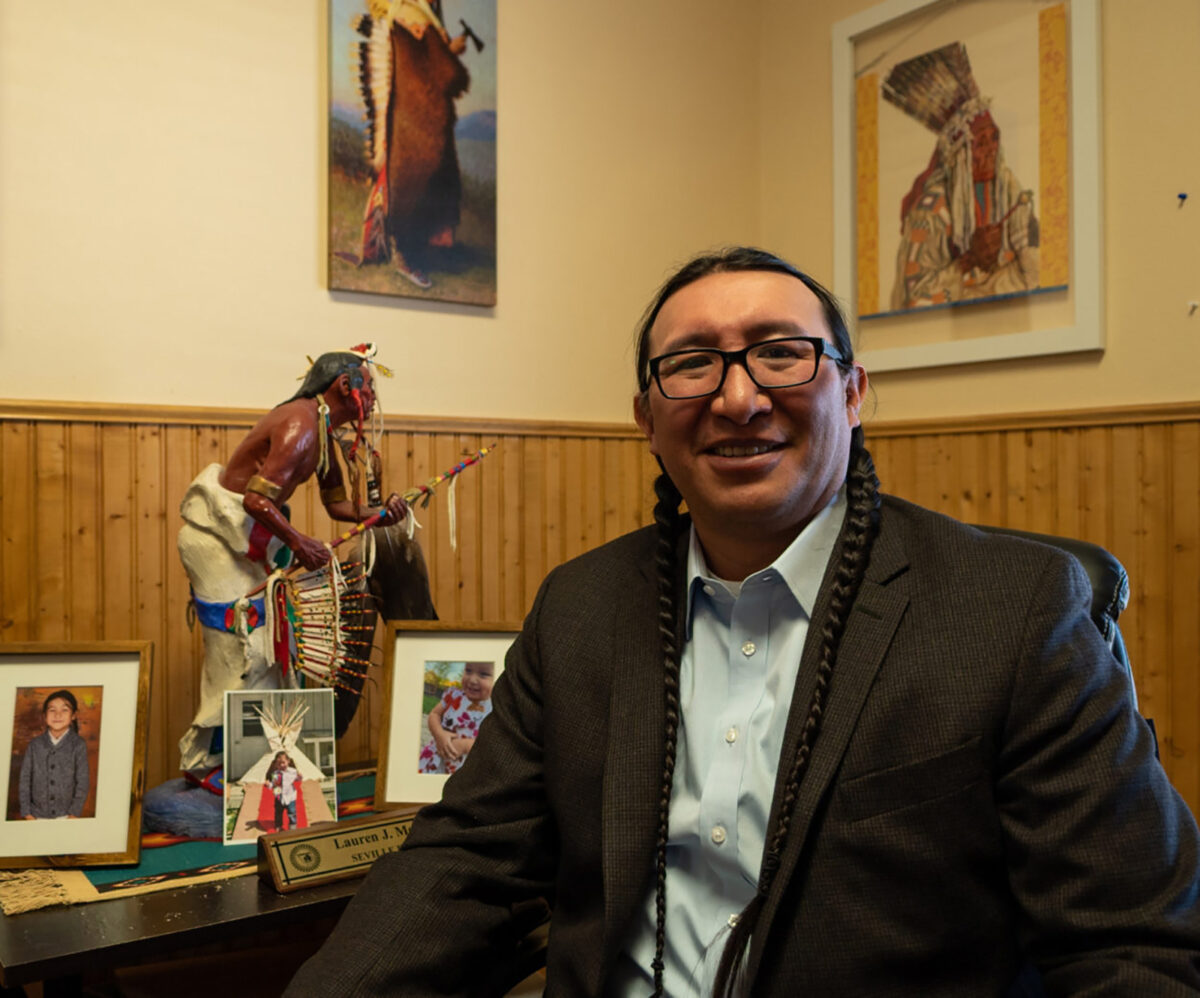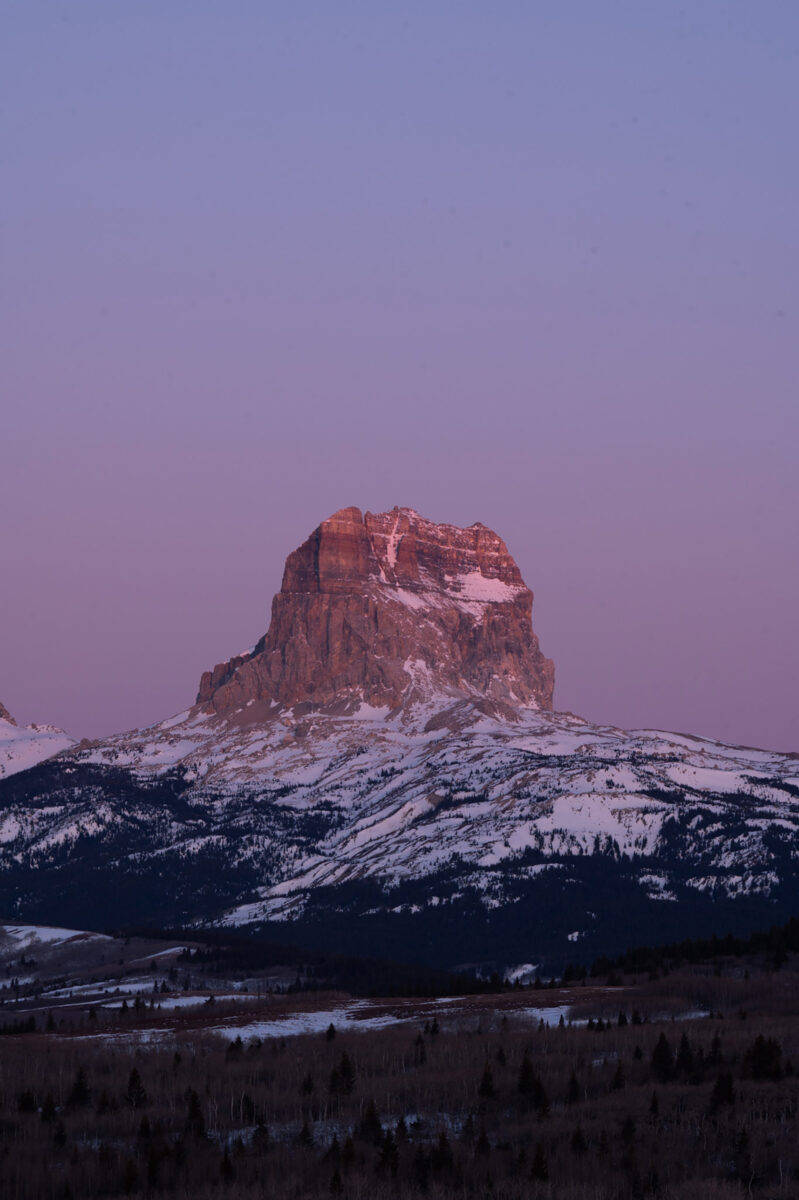Guardians of Nínaiistáko
Along the eastern border of Glacier National Park, the Aamsskáápipikani — or southern Blackfeet — have implemented the first U.S. co-management conservation program between a tribe and the National Park Service
By Chloe Olsgaard | Photos by Andy Mepham
Editor’s note: This article was produced, reported and photographed by students in the Native News Honors Project, under the University of Montana School of Journalism.
Ryan Running Wolf trudged his feet, already sunk into a foot of snow, along a dismantled fenceline in East Glacier. He gazed upon not only his jurisdiction but his future. On the border of the Blackfeet Indian Reservation of Montana and Glacier National Park lies an opening in the fence that leads to one of the Blackfeet’s most sacred places, Ninnahstako, also known as Chief Mountain.
Running Wolf, a 32-year-old enrolled member of the Blackfeet tribe, took jurisdiction over Ninnahstako and East Glacier when he was appointed to the first-ever guardianship position in the United States last August as the Chief Mountain Guardian.
Ninnahstako lies on the border of Glacier National Park and the reservation, but Running Wolf’s jurisdiction expands beyond the reservation and into the tribe’s original lands in the park.
“It was exciting knowing that I was stepping into something that hasn’t been done before, and to be able to help spearhead this, this move that a lot of people have been wanting to see happen, especially for Blackfeet,” Running Wolf said.
Guardians, trained wildlife management experts who manage protected areas, play a “vital role” in creating land-use and aquatic-use plans. That role involves connecting youth with elders, restoring animals and plants, testing water quality and training the next generation of educators, ministers and leaders, according to Running Wolf.
The Blackfeet reservation is home to the Aamsskáápipikani people, also known as the Southern Piikani, and covers 1.5 million acres, of which 26,000 now fall under Running Wolf’s jurisdiction.
He said Ninnahstako and the rest of the land he’s in charge of had been damaged over the years from tourism, overgrazing and overcapacity.
Along with wanting to keep the health of the land surrounding Ninnahstako, he also wanted to protect the spirituality within it.
As Running Wolf walked along the treeline leading up to Ninnahstako, he pointed out dozens of colorful fabrics tied around the trunks. The rainbow of fabric consists of prayer ties that are left, or burned, at the sight of ceremonies as an offering for the Great Spirit, said Running Wolf.
“It’s definitely got a different feel to it, especially from other parts of the reservation, just because there’s such a cultural significance to it,” Running Wolf said. “This mountain used to be a vision quest site for our people and it’s considered to have more of the sacred powers to it.”
Running Wolf said that almost immediately after the guardianship program was proposed and passed in front of Congress last September, Blackfeet Fish and Wildlife got to work filling that position. Running Wolf, who was originally chief game warden at the time, had never even heard what a guardian was until he was offered the job.
Chuck Sams, an enrolled member of the Confederated Tribes of the Umatilla Indian Reservation, became the first Native American to take on the role of director of the National Park Service in December 2021.
Last year he testified in favor of introducing a nationwide co-stewardship policy. The policy did not specifically mention guardianship programs, but it paved the way for them to be implemented. The passing of the policy influenced the Blackfeet to bring a proposal to Glacier National Park officials to establish a guardian position.
“All national parks are located on Indigenous ancestral lands and this policy will help ensure tribal governments have an equal voice in the planning and management of them,” Sams said in a press release last September. “I have been an advocate for co-stewardship of federal lands for more than 27 years and I am pleased to see a national emphasis placed on this necessary work.”
Gina Kerzman, a non-enrolled Blackfeet tribal member and Glacier National Park’s public information officer, said the park approved the proposal and reserved the unit through 2029. The park redirected prior grant funds from a previous “range rider” program that was funded by Glacier National Park Conservancy.
Kerzman said the previous program funded horseback riders to remove cattle that wandered into the park from the reservation. With the creation of the Ninnahstako Unit, range riders were no longer needed as the range units were no longer used for cattle leasing.
Since Running Wolf was appointed to the guardianship last August, he said he’s been busy updating and reporting on the southern and eastern borders of his newfound jurisdiction.
Several obstacles have come Running Wolf’s way, including thick vegetation, a short field season and cattle.
Running Wolf said one of the reasons the unit is updating fencing and borders by Glacier is to help combat interferences with wildlife migrations between Glacier National Park and the Blackfeet reservation.
From a century of colonialism and dispossession, billionaires and tourism now stand in the way of a traditional and proper return of Glacier land.

Breaking down fences
Along Duck Lake Road, near the east entrance of Glacier National Park, lies a snowy flat where hundreds of elk hibernate during the winter. In early March, Running Wolf partook on a helicopter fly-over and counted a combined herd of around 426 elk migrating through that area.
As Running Wolf drove along that bumpy road, he outlined that path of migration. He traced his finger along the flat top, over a few dirt roads covered in ice, across a highway and onto a large open field in North Browning.
The flat top area near St. Marys, all the way up into East Glacier, lies Zone 1 of Running Wolf’s jurisdiction. A jurisdiction that Running Wolf said looked like a bunch of zigzags that someone randomly squiggled.
“Looking at a map you’re like ‘yeah, looks good, let’s do it,’” Running Wolf said. “And then you get up here and the terrain is an obstacle in itself.”
He stuck his head out of the car window as he looked up at 10 to 30-foot cliffs that were overgrown with trees on top of rocks that could landslide at any minute. Other borders of the jurisdiction, which he said needed to be altered, ran over water lines, graves and one non-tribal-owned ranch.
Billionaire Joe Ricketts, a non-tribal member and the owner of the Chicago Cubs, has owned a ranch near East Glacier since 2019. The ranch, equivalent to 2% of the entire reservation’s size, is surrounded by five-foot fencing that houses Ricketts’ buffalo.
In 2019, the land was put up for bid after the previous non-tribal owner had passed. That land, which wasn’t under a tribal lease or tribal-owned, was sold to Ricketts after he outbid the Blackfeet’s offer.
Running Wolf said that area of fencing resulted in damage to migration patterns of elk, buffalo, deer and moose. Several fences currently run along highways on the reservation and have little to no openings for wildlife to cross. The openings that do exist are often too tall for baby animals or too small for larger animals, including moose, to get through.
“So that (disruption) has been an issue,” Running Wolf said. “And this helps. This also helps out with the research that we’re trying to do by trying to get some data on their migration.”
Running Wolf said that the department met with Ricketts’ lawyers and biologists last summer to discuss ways to make that fencing more wildlife friendly. He added that the updated fencing would “hopefully” be placed around Ricketts’ property.
“We’re trying to find that middle ground, where they can consult on their bison operation while keeping them in and keeping them protected,” Running Wolf said. “All of that while still allowing our wildlife to move freely in and out.”
The migration research involves two ongoing studies about elk and moose, with the elk study being a priority not only for his jurisdiction but south along the Rocky Mountain Front.
The studies being done are a way to help “combat” Ricketts’ buffalo fences, by analyzing migration patterns around that obstacle, according to Running Wolf.

A step in the right direction
Running Wolf became interested in wildlife management and conservation after working for fisheries on the reservation in high school. He wanted to work for the Blackfeet Fish and Wildlife Department but changed his career path to law enforcement after attending Blackfeet Community College.
After taking on the job as a police officer for several years, he ended up on the same path he started and always wanted to pursue–with Blackfeet Fish and Wildlife as a game warden and now guardian.
“There were a lot of mixed emotions,” Running Wolf said. “I had been in law enforcement for 10 years and you put a lot of your blood, sweat and tears into that. So I was a little sad, especially cleaning up my truck and turning in my weapons and my vests and my badge in particular.”
Running Wolf, a father of two boys, said that once the ball of the program got rolling, his sadness dissipated and turned to an excitement his kids already shared.
“My kids were pretty happy about it because I was finally home,” Running Wolf said. “Before, I was always getting called out to work, or had court or training or something else that was going on.”
He spoke about hunting, fishing and venturing in the Ninnahstako area with his sons, one of which recently shot his first elk not too far away. Along with wanting to protect the land for his community, he also wanted to preserve its beauty for his children and the generations to come through the work the guardianship will provide.
Running Wolf described Blackfeet Tribal Business Council member Lauren Monroe Jr. as a huge advocate for co-management initiatives and a key to spearheading the guardianship program. Monroe Jr., vice chairman of the council and an avid hunter, said he expressed interest to the council about those designated 26,000 acres as an area for the land to recover, instead of leasing it out and risking cattle damaging it.
Monroe stressed that the council didn’t want that land managed under colonial styles, because those forms of management prevent interacting with the environment but encourage “leaving no trace.”
“And I don’t like to use the word conservation because it gives the definition of ‘you can only access it through X amount of (entry) points,’” Monroe said. “And I think that’s a really Western viewpoint of management, whereas we have to interact with it according to our culture.”
Part of colonial conservation entails fencing different lands. Running Wolf said that fences surrounded almost all 26,000 acres of his jurisdiction. He said that many needed to be repaired, moved or taken down completely.
These borders and fence lines, from the east of Glacier National Park into the reservation, will soon be guiding wild buffalo back into their ancestral lands.

A long time coming
For more than 100 years, buffalo have been missing from their original lands in Glacier National Park, until now. In 1883, buffalo were almost extinct in Montana, along with the rest of the United States. The mass-colonial eradication of buffalo forced starvation winters on many tribes in Montana, including the Blackfeet, who relied on the buffalo as a source of food, clothing, shelter and tools.
“There was a mass genocide and mass generational trauma that happened to both of us, Native Americans and buffalo,” said Wyett Wippert, a Blackfeet business owner, and community engagement administrator for the Iinnii Initiative. “And we’ve done that journey separately, but together.”
The Iinnii, the Blackfeet word for buffalo, are deemed as a cultural keystone species to the tribe and are known as caretakers of the land, Wippert said.
Along with the cultural effects of this reintroduction, members of the Iinnii Initiative and Blackfeet Fish and Wildlife believe the buffalo will have positive effects on the health and growth of the land.
Before the herd can be introduced, Running Wolf and other range rider units removed the cattle from leased properties near East Glacier. Those cattle roamed into the park over time, resulting in over-grazed grass and poor soil health in many regions of that east sector.
“The tribe and the Bureau of Indian Affairs consolidated six ranger units that create this Chief Mountain unit, or the Ninnahstako range unit,” Running Wolf said.
The keystone species not only provides a cultural connection for the land, but ecological as well. As buffalo graze, their manure supplies essential nutrients and their hooves aerate the soil by burying seeds and creating moisture pockets.
In the early 1900s, the remaining buffalo on original Blackfeet lands, where Glacier National Park stands today, were purchased by the Canadian Government from the tribe in hopes of saving what little of them was left. Since then, the buffalo have resided within Elk Island National Park for more than 100 years, according to Wippert.
Spirit Hills Ranch, located off of U.S. Highway 89 on the reservation, has been home to the direct descendants of the Glacier buffalo herd after they were transferred from the park in Alberta, Canada, in the spring of 2016. Up until now, the population has grown upwards of hundreds.
The descendants that currently reside on that ranch will be moved into Running Wolf’s jurisdiction, and guided by the fencing, onto Ninnahstako, and into Glacier National Park.
“I think overall, everybody wants to reach the goal of getting the bison there, having it preserved and protected,” Running Wolf said. “It’s just figuring out how we do that collectively.”
Because Glacier National Park extends to the Canadian border, Running Wolf has concerns about the buffalo wandering past international lines.
“That’s an issue because the ranchers up there in Canada don’t want them and they can actually kill them,” Running Wolf said. “Another issue is them getting into Waterton and not coming back.”
The arrival of the descendants prompted not only the reintroduction of the herd but the reintroduction of sacred buffalo practices.
“They’ve had a long journey to come back here,” Wippert said. “And now that they’re here, we are also doing our work to reconnect with them, really learn from them, highlight what they teach us and their teachings that have been lost for a long time.”
Songs, stories and ceremonies around the buffalo, entailed within Blackfeet culture, happened in Glacier National Park over 100 years ago when the animals still roamed the lands.
With the buffalo’s absence from the park, many of those practices halted, according to Treyace Yellow Owl, a member of the Blackfeet Land Board and a fluent speaker of the Blackfoot language.
Yellow Owl, an enrolled member of the Blackfeet, has also participated in the Native Speaks program in Glacier National Park. The program has provided Blackfeet members a platform to share their history, stories and knowledge about the park with tourists.
“We’re going to be able to have ceremony back in the mountains again, who knows what that’s gonna awaken and what energy is going to wake up that’s been dormant and sleeping for some years,” Yellow Owl said.
The reintroduction also prompted several projects on the reservation including a buffalo-meat program at the Blackfoot Language Immersion School, buffalo hunts at Browning High School and Iinnii Days at Spirit Hills Ranch, Wippert said. Iinnii Days in the past have involved prayers, buffalo harvests, buffalo jump reenactments, powwows and Indigenous film collectives.
“Our people were matriarchal societies,” Yellow Owl said. “Buffalo are matriarchs, they have a lead cow. She’s the head woman. She’s one that gets them going and tells them where to go. Blackfoots, we watched and mirrored their society, we mirrored their social interactions. We watched how the wolves hunted the buffalo, that’s how we ended up hunting the buffalo.”

Sacred steps
Running Wolf said one of the guardianship’s objectives is to recruit Blackfeet members, primarily youth, to take on internships and jobs in that sector. He recently put in a grant for summer youth interns, looking to hire two to four people.
Along with hiring interns, the program is in the process of hiring another guardian to advocate and work solely toward protecting the cultural significance of that land. The Tribal Historic Preservation Office is currently in the process of interviewing candidates, Running Wolf said.
“We’re kind of focusing more on the fish and wildlife side, but me and the other guardian are supposed to kind of collaborate and work closely together to kind of hit both sides,” Running Wolf said. “We’d really like to preserve the cultural kind and natural significance of Chief (Mountain) and preserve it as much as possible.”
Running Wolf said the guardian taking on the cultural aspect of the program would specialize in protecting culturally significant areas to the Blackfeet including teepee rings, vision quest sites, lodges and more.
Ninnahstako, 9,085 feet tall, is one of the most prominent peaks along the Rocky Mountain Front and is formed out of rocks that date back 1,450 million years old. He added that the mountain was, and still is, a vision quest for the Blackfeet as it’s considered to have “sacred powers” within it, not just rocks.
While Running Wolf walked his way along the fence line he’s been tasked with tearing down, he smiled. “That’s our home,” he said as he glanced up and smiled at the sight of Ninnahstako. The outline of the mountain cast a shadow over East Glacier.
“You just feel tied to it, knowing that your ancestors did everything possible to preserve it and have it available for you to experience,” Running Wolf said.